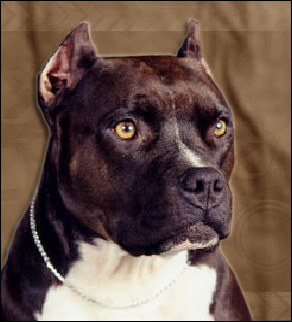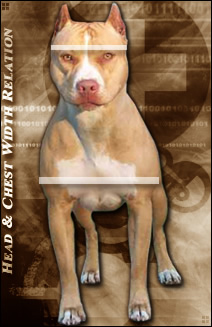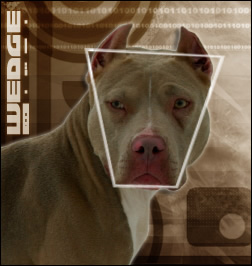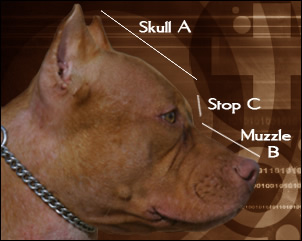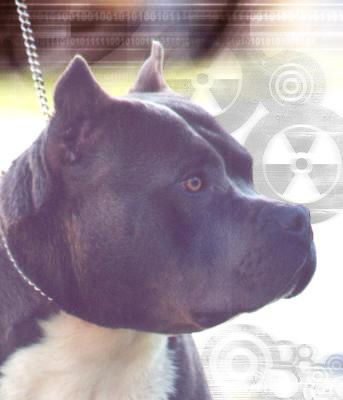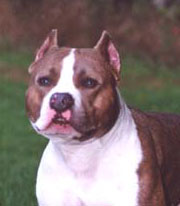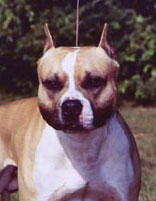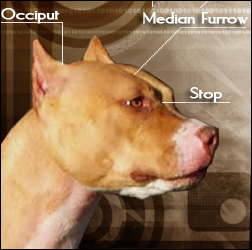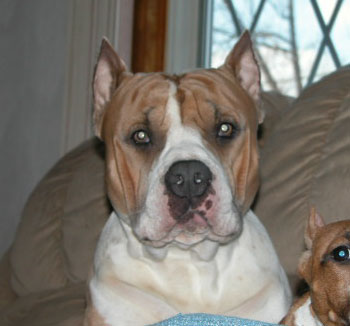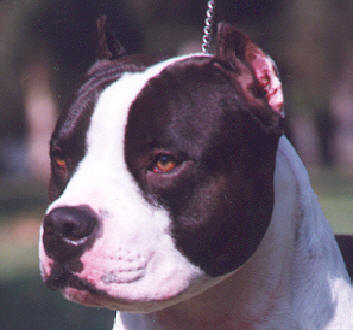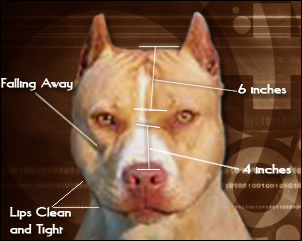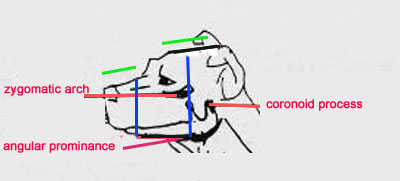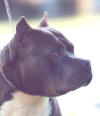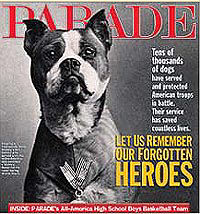Head
THE APBT IS no more A HEAD BREED than any other. |
RULE #1 |
The APBT IS A COMPLETE TOTAL AND BALANCED DOG!- HEAD structure is important but not overwhelmingly so! A massive skull has a negative impact on a breed because of the added weight without proportionate increase in strength. |
RULE #2 |
| In actual practice, a dog with a small head with proper structural mechanics, has the advantage and should be preferred to a dog with a massive head that does not fulfill all of the structural requirements. |
| RULE #3 |
Bitches with overly doggy heads should not be considered Males with overly bitchy heads should not be considered |
The head is of medium length, with a broad, flat skull, and a wide, deep muzzle |
(wide and deep muzzle is very important) . Why wide and deep (not exaggerated)? A straight, box-like muzzle and well developed mandible will not have much to do with the biting power but will endure more punishment. |
The APBT head is unique and a key element of breed type. It is large and broad, giving the impression of great power |
This animal has a very nice head piece. |
The head of the APBT should never be exaggerated. Certainly the size of the head is NOT disproportionate to the size of the body. Looking at the dog from the front the width of a correct head should be approximately 2/3 the width of the dogs shoulders. The head is about 20% wider at the beginning of the jaw (cheeks) than the neck at the base of the skull. |
This figure indicates how a proper head to shoulder ratio can be visualize. Perhaps a better way to visualize this is standing above the dog and looking straight down. |
Viewed from the front, the head is shaped like a broad, blunt wedge. |
FIGURE 4- this figure depicts what is meant by wedge shaped head. The white shape is the wedge. The cheeks should protrude from this wedge as shown in the overlay |
When viewed from the side, the skull (A) and muzzle (B) are parallel to one another and joined by a well defined, moderately deep stop (C). |
FIGURE 5 - This shows what is meant by the muzzle and skull being in parallel lines with a moderately deep stop. Deep meaning two things in this case one would hope. The steepness of the stop should not be shallow like that of a bull terrier nor should it be more vertical like that of an American Bulldog. Thus the angle and depth should be taken into account. The APBT must be AVERAGE AND BALANCED in all aspects of conformation to promote it's functional diversity. This includes the size and shape of the head. ALSO NOTE: the muzzle has a straight topline (see standard text below). There is no turn up at the nose and no "Roman" bridge running from the stop. Also note how tight the lips are along the side with no jowls or flews. |
Supraorbital arches over the eyes are well defined but not pronounced. |
FIGURE 6 shows a dog with naturally highlighted supraorbital arches. These are above each eye and rise just over the black markings giving this female a questioning yet intense look. |
The head of the APBT is well chiseled, blending strength, elegance, and character. |
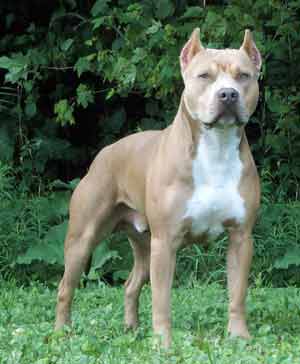 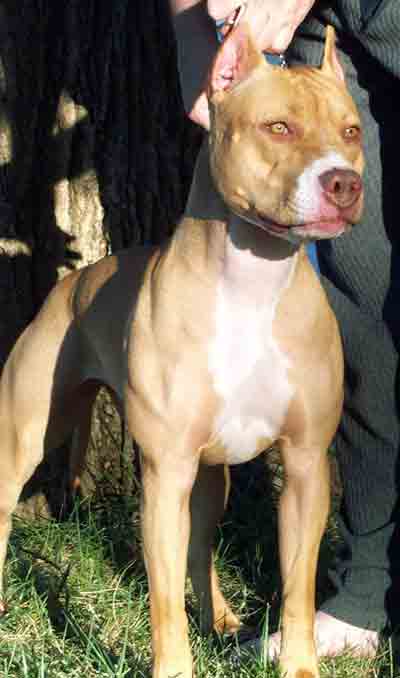 |
FIGURE 7-These figures above (figure 6 and 7) show well chiseled heads that portrait a good blend of strength,, elegance, and character . These are two very different bloodlines within the APBT. The difference in appearance should not be taken for lack of proper conformation. Both fit the standard very closely. |
 |
The image above shows a range of male and female heads. The heads represented in the middle are moderate. The female heads to either side are outside of the moderate range. Notice that females should look like females and males should look like males. |
The APBT has a wide variety of sub-types |
Care must be taken when judging obviously different bloodlines. Judges comment: One must look past the characteristics of specific blood-lines which lend a specific "look" to the head. This "Look" may be that of the judges own "type" of dog lending bias to scoring. This should be avoided or judges should not be in the ring. |
Unfortunately in the UKC judges seem to be determined only to pick on sub-type which is dramatically decreasing the overall diversity of the UKC show APBT. It is a travesty that so many exceptional examples of the breed are no longer being shown in UKC because judges are basing decisions on mental pictures rather than structural and functional understanding. |
The two pictures above (Fig 7) show dogs with great proportion between the size of the head and the body. The bitch to the left has a nice feminine head while the male to the right looks like a dog, yet both have that chiseled look of power. Both of these dogs are of different bloodlines and both are equally correct and beautiful to a true connoisseur of the APBT. |
The head cannot, must not be overly massive. A massive head will NEVER give advantage to the dog when doing the jobs they are bred for (contrary to urban myths SEE RATIONALE BELOW ) on the contrary a too big head will take the advantage away from a dog. It is not the size of the head that gives power to the bite it is proper mechanics and structure. |
RATIONALE : A dog with an overly massive head is disadvantaged because they must carry the extra weight of the skull bone and associated meat with the neck. This creates a need for a heavier chest and shoulders to compensate (loaded shoulders-a fault), which takes away from the balance between the forequarters and the hindquarters reducing the efficiency of overall movement and agility particularly lateral movement. |
AMSTAFF BREEDER: THIS (oversized heads with weak lower jaw) IS BECOMING COMMON IN SOME OF THE AKC AMSTAFF, WHICH HAS BEEN CRITICIZED FOR BECOMING A HEAD AND CHEST BREED FORSAKING BALANCE. |
SKULL - The skull is large, flat or slightly rounded, deep, and broad between the ears. Viewed from the top, the skull tapers just slightly toward the stop. |
The shape of the top skull is of particular interest in these days of overdone and over massive dogs. Bone structure of the top skull should be well visualize by the judge and certainly not covered or overly padded by flesh and or muscle. This typically looks like a dome skull. The top of the head should not be overdeveloped as this offers absolutely no advantage to a dogs ability. |
| The top of the head should be essentially flat with parallel angles to the top of the muzzle. The padding on the top skull in males should result in only a slight rise, while in females there should be less of a rise. But the planes SHOULD NOT deviate from the planes of the muzzle. |
Seemingly this is aA very impressive head but true understanding of conformation shows it is lacking in merit. The planes of the top skull compared to the muzzle are dramatically different angles, the muzzle compared to the padding and development of the rest of the head is snipey (believe it or not) and the dog lacks underjaw (not to be confused with depth from zygomatic arch to lower mandible which is here in abundance). This head has semblence of mastiff rather than a bull and terrier breed. |
The skin of the head and skull should be very tight except for the quizzical wrinkles of the forehead that give the dog that puzzled yet intense look. Especially undesirable are dogs that are very lippy or have extra flesh around the mouth including jowls. |
One of the MORE important aspect of the head which is too often ignored is the LOWER JAW. |
The Cheek muscles are also becoming overly developed as one of those fad characteristics. Cheek muscles should be prominent but not exaggerated. There is a standard and the standard does not present a dog that has gross overly developed cheek musclulature. . |
These handsome dogs have overly developed cheek muscles. This is considered exaggeration and lacks moderation of form leading to reduction in optimization of function. (photos by Valerie) |
.
To Learn more about head structure visit the following pages

